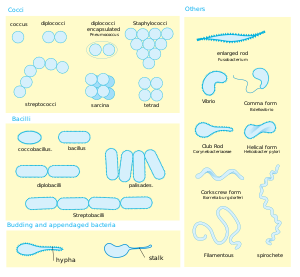Bacteria: Domain of micro-organisms
Bacteria (singular: bacterium) are very small organisms.
They are prokaryotic microorganisms.
| Bacteria | |
|---|---|
 | |
| Scanning electron micrograph of Escherichia coli rods | |
| Scientific classification | |
| Domain: | Bacteria Woese, Kandler & Wheelis, 1990 |
| Phyla | |
Actinobacteria (high-G+C)
Aquificae
Acidobacteria | |
| Synonyms | |
| Eubacteria Woese & Fox, 1977 | |
Bacterial cells do not have a nucleus, and most have no organelles with membranes around them. Most have a cell wall. They do have DNA, and their biochemistry is basically the same as other living things. They are amongst the simplest and the oldest organisms.
Almost all bacteria are so tiny they can only be seen through a microscope. Bacteria are made up of one cell, so they are a kind of unicellular organism. They were one of the earliest forms of life, and are simple single-celled organisms. They include extremophiles, which live in extreme habitats.
There are probably more individual bacteria than any other sort of organism on the planet, except viruses. Most bacteria live in the ground or in water, but many live inside or on the skin of other organisms, including humans. There are about as many bacterial cells as human cells in our bodies. Some bacteria cause diseases, but others help us in everyday activities like digesting food (gut flora). Some we use in factories to make cheese and yogurt.
The founder of bacteriology was a German biologist called Ferdinand Cohn (1828–1898). He published the first biological classification of bacteria, based on their appearance.
Reproduction and gene transfer
A bacterium reproduces (creates more bacteria) by dividing in half and creating two "daughter" cells. Each daughter is identical in shape to the parent.
Bacteria do not have sexes, but they do transmit DNA by several kinds of horizontal gene transfer. This is how they share resistance to antibiotics from one strain to another. The complete DNA sequence is known for many bacterial strains. Each bacterium has only one chromosome.
Shape
Bacteria vary widely in size and shape, but in general they are at least ten times larger than viruses. A typical bacterium is about 1 µm (one micrometer) in diameter, so a thousand bacteria lined up would be one millimeter long. There are about five nonillion (5×1030) bacteria on Earth.
Bacteria are identified and grouped by their shapes. Bacilli are rod-shaped, cocci are ball-shaped, spirilla are spiral-shaped, and vibrio are shaped like a comma or a boomerang.

Pathogens
Pathogenic bacteria, the harmful kind, enter the human body from the air, water or food. Once inside, these bacteria attach themselves to or invade specific cells in our respiratory system, digestive tract or in any open wound. There they begin to reproduce and spread while using your body's food and nutrients to give them energy to help them reproduce.
Extremophiles
Some bacteria are extremophiles. Some microbes thrive inside rocks up to 580 meters below the sea floor under 2.6 kilometers of ocean off the Pacific Northwest of the United States. According to one of the researchers, "You can find microbes everywhere — they're extremely adaptable to conditions, and survive wherever they are."
Viruses
Viruses were the first and are the most serious enemies of bacteria. Everywhere bacteria are, they get attacked by viruses. The viruses which attack bacteria are called bacteriophages.
Something is now known about how bacteria protect themselves against viruses. Some bacteria and most archaea have CRISPR–Cas systems as an adaptive defence against viruses. These keep sections of viral DNA. These are used to target and destroy later infections by the virus. The process is similar to RNA interference.
History of their classification
All modern ideas start with the sequence analysis of DNA and RNA. In 1987, Carl Woese, the forerunner of the molecular phylogeny revolution, divided bacteria into 11 divisions based on 16S ribosomal RNA (SSU) sequences:
- Proteobacteria: Purple bacteria and their relatives
- Alpha subdivision: purple non-sulfur bacteria, rhizobacteria, Agrobacterium, Bartonella, Rickettsiae, Nitrobacter)
- Beta subdivision: (Rhodocyclus, (some) Thiobacillus, Alcaligenes, Spirillum, Nitrosovibrio
- Gamma subdivision: enterics, fluorescent pseudomonads, purple sulfur bacteria, Legionella, (some) Beggiatoa
- Delta subdivision: Sulfur and sulfate reducers (Desulfovibrio), Myxobacteria, Bdellovibrio
- Gram-positive Eubacteria
- High-G+C species - Actinobacteria (Actinomyces, Streptomyces, Arthrobacter, Micrococcus, Bifidobacterium)
- Low-G+C species - Firmicutes (Clostridium, Peptococcus, Bacillus, Mycoplasma)
- Photosynthetic species (Heliobacterium)
- Species with gram-negative walls (Megasphaera, Sporomusa)
- Cyanobacteria and chloroplasts (Aphanocapsa, Oscillatoria, Nostoc, Synechococcus, Gleoebacter, Prochloron)
- Spirochaetes and relatives
- Spirochetes (Spirochaeta, Treponema, Borrelia)
- Leptospiras (Leptospira, Leptonema)
- Green sulfur bacteria (Chlorobium, Chloroherpeton)
- Bacteroides, Flavobacteria and relatives
- Bacteroides (Bacteroides, Fusobacterium)
- Flavobacterium group (Flavobacterium, Cytophaga, Saprospira, Flexibacter)
- Planctomyces and relatives
- Planctomyces group (Planctomyces, Pasteuria)
- Thermophiles (Isocystis pallida)
- Chlamydiae (Chlamydia psittaci, Chlamydia trachomatis)
- Radioresistant micrococci and relatives
- Deinococcus group (Deinococcus radiodurans)
- Thermophiles (Thermus aquaticus)
- Green non-sulfur bacteria and relatives
- Chloroflexus group (Chloroflexus, Herpetosiphon)
- Thermomicrobium group (Thermomicrobium roseum)
- Thermotogae
Related pages

References
This article uses material from the Wikipedia Simple English article Bacteria, which is released under the Creative Commons Attribution-ShareAlike 3.0 license ("CC BY-SA 3.0"); additional terms may apply (view authors). Content is available under CC BY-SA 4.0 unless otherwise noted. Images, videos and audio are available under their respective licenses.
®Wikipedia is a registered trademark of the Wiki Foundation, Inc. Wiki Simple English (DUHOCTRUNGQUOC.VN) is an independent company and has no affiliation with Wiki Foundation.